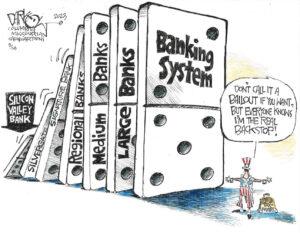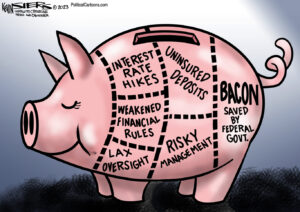A Lemon of a Bailout
With GM's bankruptcy filing on Monday, we the people have become majority owners of a museum-quality piece of industrial history.We were a GM family when I was growing up, back when Americans could be roughly divided into clans according to which of the Big Three automakers they patronized. My father was convinced that cars made by General Motors were better than those made by Ford or Chrysler, though he never really explained why. I learned to drive in a 1964 Buick LeSabre that wallowed its way through turns like an ocean liner, offering precious little margin of error to a neophyte behind the wheel. Perhaps to compensate for that failing, the ride was as soft as a pillow.
I guess we’re all GM families now. With the company’s bankruptcy filing on Monday, we the people have become majority owners of a museum-quality piece of industrial history. Once, General Motors controlled more than half the domestic market; now, only in Detroit or within commuting distance of one of the company’s assembly plants can you find the kind of fierce brand loyalty that made GM’s dominance possible.
President Obama was right to do everything possible to ease GM’s slide into bankruptcy — and to facilitate the sale of what’s left of Chrysler to Italy’s Fiat — if only to avoid the disruption that would have resulted from sudden failure. In the midst of a deep recession, it would have made no sense to throw hundreds of thousands of people out of work.
But even with the additional $30 billion in public funds that Obama has agreed to pour into GM, the company announced plans to close nine more plants — four of them in Michigan, already the state hit hardest by the recession — and three parts distribution centers. For workers at those facilities, there appears to be no soft landing in sight.
Fritz Henderson, the company’s chief executive, almost begged consumers to give GM another chance, promising that this time he and other executives really do understand the need to build cars that people might actually want to buy. One eminently reasonable step the company is taking is the elimination of four of GM’s many brands, which long ago ceased to make sense as a kind of ladder that buyers would aspire to climb.
Few will shed tears for the demise of the Hummer, Saab and Saturn brands. Pontiac is a different story, but we’ll forever have the sleek, fast GTOs of our youth. Quick, name a current Pontiac model. I checked, and most have forgettable names like G6 or G5. The only memorable Pontiac of recent years was the ill-conceived Aztek, a vehicle so awkward and ugly that it regularly turns up on lists of the worst cars of all time.
The roster of Chevrolet, GMC, Buick and Cadillac may still leave GM with too many brands; I’d have axed Buick, too, and my opinion should count since I’m now one of the company’s owners. The bigger issue, though, is whether GM can come to understand the American automobile market as well as Toyota, Honda, BMW and other foreign-owned manufacturers do.
Whenever GM officials start talking rhapsodically about the long-awaited Chevrolet Volt, a plug-in hybrid expected to be introduced next year, I get worried. Reportedly, the Volt will retail for about $40,000. By contrast, the Toyota Prius — which uses a different kind of gas-electric hybrid system, and consumes more gas than the Volt — can be bought for less than $25,000. That’s a lot to pay for incremental altruism.
I’m also not terribly impressed with those surveys ranking GM cars such as the Chevy Malibu ahead of Toyotas or Hondas in “initial quality.” The more relevant question is how a car holds up after years of wear and tear — and given the state of the economy, durability may become even more important.
When I was a kid, GM knew better than any other company how to make a comfortable, highway-cruising family sedan. The present-day equivalent might be the comfortable, highway-cruising hybrid SUV — but if it is, Ford got there first with the Escape. Anyone want to bet that GM makes a serious play for that market segment before the Japanese or Korean automakers do?
In truth, I don’t see much more than a temporary reprieve for General Motors and a somewhat easier landing for GM workers. Obama said his administration plans to leave management of the company to the professionals. At this point, I have to wonder why.
Eugene Robinson’s e-mail address is eugenerobinson(at)washpost.com.
© 2009, Washington Post Writers Group
Your support is crucial…With an uncertain future and a new administration casting doubt on press freedoms, the danger is clear: The truth is at risk.
Now is the time to give. Your tax-deductible support allows us to dig deeper, delivering fearless investigative reporting and analysis that exposes what’s really happening — without compromise.
Stand with our courageous journalists. Donate today to protect a free press, uphold democracy and unearth untold stories.







You need to be a supporter to comment.
There are currently no responses to this article.
Be the first to respond.